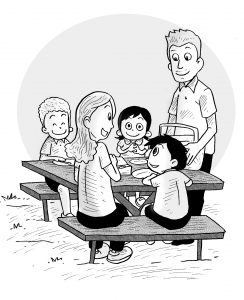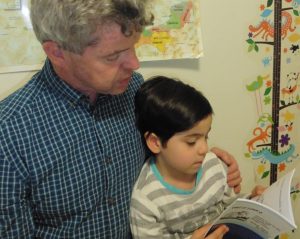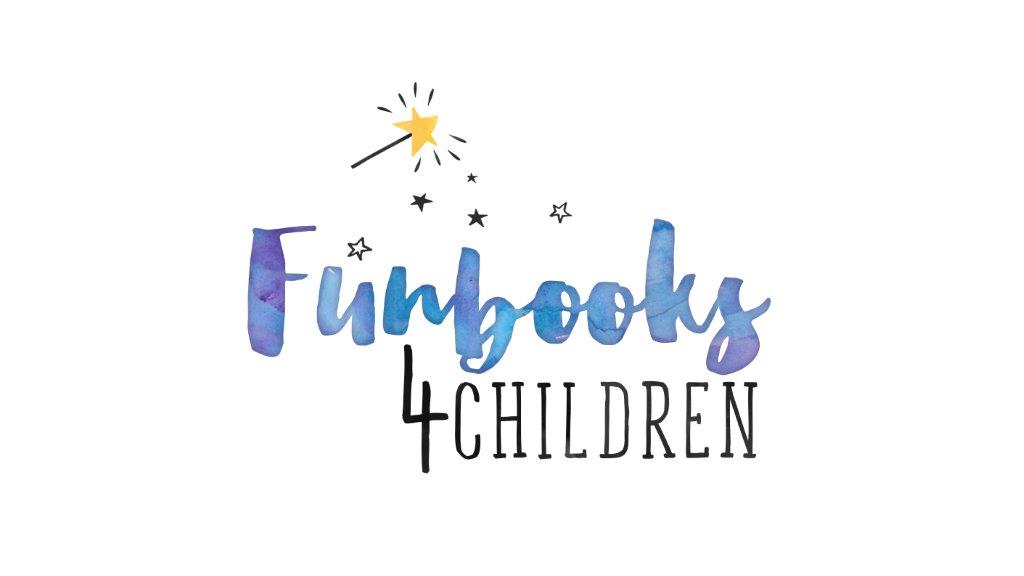Parent Hints

FREE: If these helpful hints have been useful to you, email Marguerite on funbooks4children@hotmail.com and she will send you PDF versions of further helpful hints.

BUILDING VOCABULARY – speak TO children and WITH children
A wide vocabulary is most important for parents and carers to build up with babies and young children. This is a prerequisite for reading. If children in the first year of formal schooling are introduced to letter-to-sound correspondence they will learn to decode phonically regular words. However, if they decode words they do not know and understand, this is referred to as “barking at print”. I assume that the main reason for reading, after all, is to transmit meaning from the text to the reader. So, to be able to decode something does not necessarily mean you are reading it in the sense of understanding it. For example, you can probably decode the following: “frigus est ibi”. But unless you studied Latin you will probably not know it means “it is cold there”. So, while you could decode the words they would likely hold no meaning for you, and you were not really reading. Thus, it is vital that children bring as wide a vocabulary to learning to read as possible. In the series The Kid in the Wild West, for example, I help with this: when I introduce a phonically regular word such as “cactus” or “armadillo” which beginning readers may be able to decode, I will provide an illustration of a cactus or an armadillo for those children who have not come across that word before – for whom it is not part of their vocabulary – so that they understand what they are reading.
However, the notion of vocabulary is more complex than that. I like to describe it for my students as follows: try to think of it as though we have two vocabularies – a passive vocabulary and an active vocabulary. It happens that we come across a novel word we have not met before and we understand what that word means in a sentence because the context provides us with the meaning. It is therefore part of our passive vocabulary – we understand what the word means. At first we will not be able to use that new word ourselves; it will not readily spring to mind as we speak. When we have heard the word a few times, however, we become able to use that word ourselves; it has become part of our active vocabulary. Generally, our passive vocabulary is much larger than our active vocabulary.
We see this clearly exemplified as children learn to speak. Two-year-olds will often understand much of what is said to them, but will only gradually be able to construct complex sentences and use all those words themselves that they quite obviously understand. It is for this reason that I have headed this helpful hints piece “Talk TO children and WITH children”. Let them hear a rich variety of words and gradually they will understand them and begin to use them correctly as they construct speech. Those children who have a wide vocabulary on entry into formal schooling generally learn to read easily.
Letter NAMES and Letter SOUNDS – initial, medial, and final sounds
Prior to going to school, children will often learn the alphabet – through singing the alphabet song perhaps. Those are letter NAMES. In this document I will use capitals to denote letter names. There are 48 sounds in English but only 26 letters, so we have to join some together to form all the sounds we need when spelling words. For the purposes of explaining what I mean in this document, I will use lower case letters to denote the letter sound, so the letter name C has the sound /c/ (as in ‘cat’).
Before starting formal schooling, it is useful if children can identify the individual sounds in words and can run them together to form a word. They do not need to relate the sounds in a word to the letter names. This should be done orally. It is important that if children hear the word ‘pen’, they can identify the initial sound /p/, the final sound /n/ and the medial sound /e/. Equally, if they hear the sounds p/, /e/, /n/ articulated separately, they need to be able to put them together and know they make the word ‘pen’.
This ability is largely developmental, so if your child can’t do it shortly before starting school, play some games where you emphasise the beginning sound of words – such as book, biscuit, bike, and bear. Read books such as those by Dr Seuss which have rhyming words so that children gradually start to see the patterns in the final sounds in words.
A game that children enjoy is to have a number of objects on a tray such as a pen, a cup, a fork, a spoon. Then the adult and the child can play a game where they take turns saying: “Can you point to the /p/, /e/, /n/?” Note you are not saying the letter names, P, E, N; you are using the letter sounds. Say the letter sounds separately, but let them run together so the child can hear the word. You can also ask for the beginning sound or first sound in the word /p/, /e/, /n/, emphasising the one you want as follows: “What is the first sound in the word /p/, /e/, /n/?” Repeat with all the objects on the tray. Children will first hear and identify the initial sound of a word, so start with that. The next sound they learn to identify is the final sound. The sound they find the most difficult to identify is the middle sound, so leave that till last, until your child is confident in hearing and identifying the first and final sounds of words and experiences success with that.
Interestingly, back in the 1970s there was a move to teach children the phonetic alphabet and books were produced that children could read, decoding the words using the phonetic alphabet they had learnt. It proved to be a flop. The children ultimately had to come to terms with reading our alphabet so they had to learn two – the phonetic alphabet and then our usual alphabet!

HOW BEST TO PROMPT BEGINNING READERS
It is helpful if parents know what to say to their child when doing the homework reader. The helpful hint described here provides parents with the knowledge of how to prompt their child effectively when the child hesitates at a word.
When children start formal schooling they bring reading books home almost from day one. The texts in these books will predominantly cleverly be made up of two distinct categories of words:
– those that are phonically regular, such as the word ‘pen’ and ‘got’ and can be sounded out by the child; and
– those words that cannot be decoded phonically, but which children need to learn to recognise from repetitive exposure to them. They are called high frequency or sight words. Words included in this category are words such as ‘look’, ‘said’, ‘mother’ and ‘father’.
These levelled readers used by schools have excellent pictures that help with comprehension. Consequently, as your child turns each page, let him/her scan the page to take in the pictures, then point to the first word on the page, to prompt your child to start reading.
I always recommend that you, as a parent, actually quickly read through the child’s reader before letting the child read with you. You will quickly get good at identifying the phonically regular words such as ‘pen’, ‘dog’, and ‘cat’. If your child hesitates at those words, prompt your child by pointing to the individual letters saying, “sound it out, /d/,/o/, /g/.” Hopefully, your child will hear the three sounds blending together and will say the word ‘dog’. If not, give the child the word, and point to the start of the sentence to re-read the sentence with no hesitation at that word.
Then there are those words that the child should recognise by repeated exposure to the word, such as ‘look’ and ‘said’. If your child hesitates at these words, prompt by saying the initial sound, for example, ‘/s/, /s /, /s/. Hopefully the child will chime in with ‘said’. If not, give the child the word.
Then point to the start of the sentence and help the child to re-read the sentence with no hesitation at the word ‘said’.
There is a third category of word that appears increasingly frequently as children move up to higher levels of the school levelled readers. They are words that do not have a phonically regular initial sound such as ‘photo’. If such a word appears, it will usually have an illustration on the page with it to assist the child to know what the word is. If your child hesitates at such a word, give the child the word immediately and move on straight away so that the flow of what is being read is not lost. With repeated exposure to words such as ‘photo’ and ‘enough’ children recognise them on sight.

